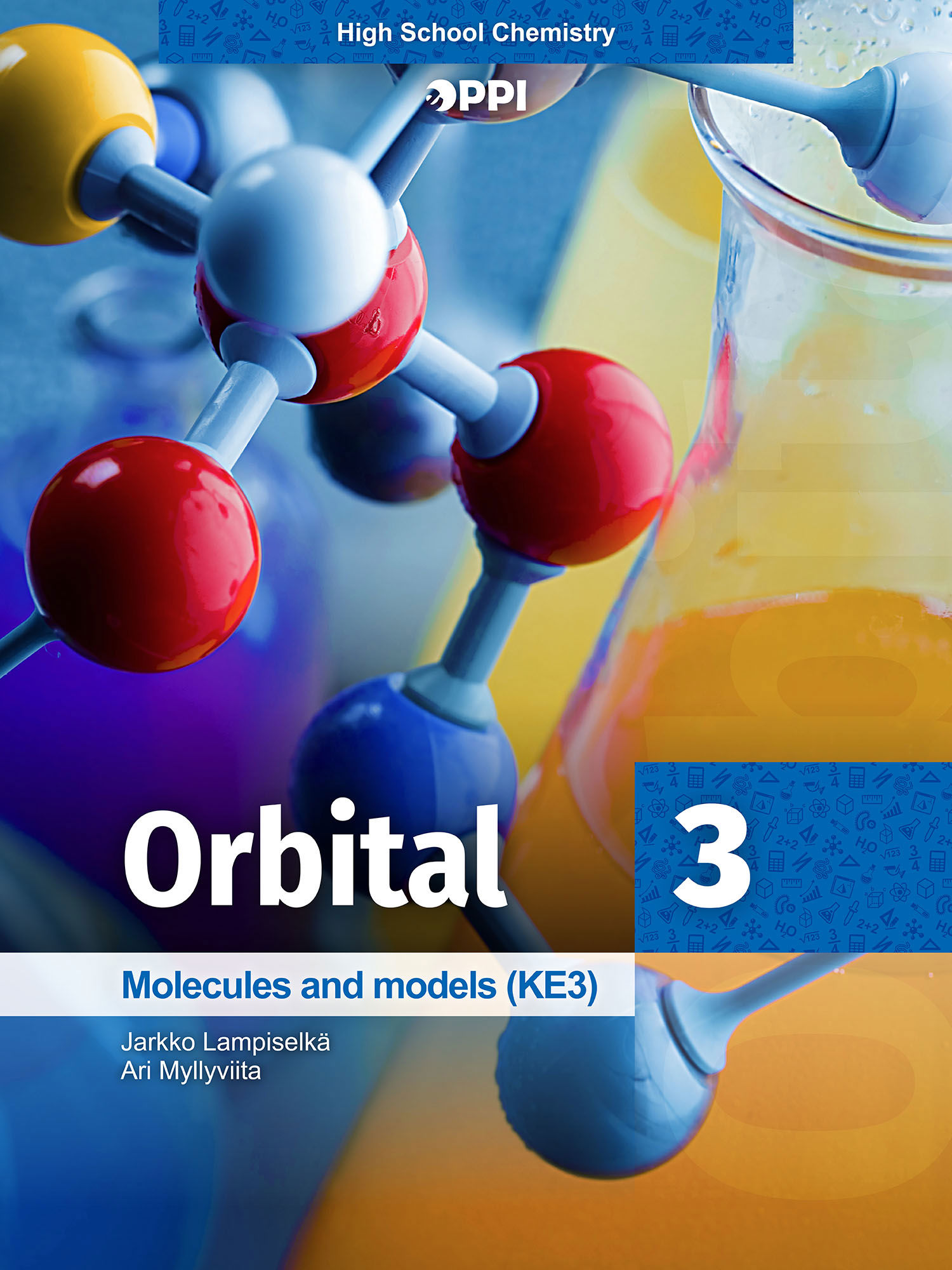
Tekijät
Jarkko Lampiselkä & Ari MyllyviitaTehtäväkokoelman tekijät
Jarkko Lampiselkä & Ari MyllyviitaKustantamo
Kuuluu paketteihin

-
Oppimateriaali sisältää 43 lukua ja 126 tehtävää, joista 22 sijaitsee kirjan luvuissa ja 104 opettajan tehtäväkokoelmassa.
-
Tekijät
Jarkko Lampiselkä & Ari Myllyviita -
Tehtäväkokoelman tekijät
Jarkko Lampiselkä & Ari Myllyviita -
Aine
Kemia, luonnontiede -
Luokka
Lukio -
Kurssi
CH3 Molecules and models -
Teoksen kieli
Englanti -
Kustantamo
e-Oppi Oy -
Kuuluu paketteihin
The Orbital 3 learning material covers the third module of upper secondary school chemistry, "Molecules and models".
The Orbital series is a modern learning material for chemistry that encourages the student to think about, investigate, and understand chemistry. The text is designed to captivate the reader. The examples feature important chemical processes and discoveries that are familiar from everyday life. In addition to traditional text explanations, animations, videos and 3D models have also been used to visualise processes.
The tasks follow the new digital final exam model, progressing from tasks that test memory skills through concepts to practical and more challenging tasks. Models and visualisation play a key role in learning chemistry.
Chemistry is learnt by visualising your own thoughts and by presenting them to other students. Discussions help to develop our own thought processes. Modelling uses simulations, but you will also need a pen and paper. Students can freely choose between visualisation methods.
Chemistry is also learnt together. Learning is social in nature, so the material encourages students to work together.
1. To the reader
Kirjanmerkki |
Luku |
|---|---|
| 1.1. | Preface |
| 1.2. | Introduction to organic chemistry |
2. Hydrocarbons
Kirjanmerkki |
Luku |
|---|---|
| 2.1. |
Hydrocarbons
Tutustu ilmaiseksi! |
| 2.2. | Alkanes |
| 2.3. | Alkenes |
| 2.4. | Alkynes |
| 2.5. | Aromatic compounds |
| 2.6. | Experimentation |
3. Oxygen compounds of carbon
Kirjanmerkki |
Luku |
|---|---|
| 3.1. | Alcohols |
| 3.2. | Aldehydes and ketones |
| 3.3. | Carboxylic acids |
| 3.4. | Ethers |
| 3.5. | Esters |
| 3.6. | More information: Esters |
| 3.7. | Inorganic compounds |
| 3.8. | Reactions of carbon and oxygen compounds |
| 3.9. | Comparison of properties |
| 3.10. | Experimentation |
4. Nitrogen compounds of carbon
Kirjanmerkki |
Luku |
|---|---|
| 4.1. | Amines |
| 4.2. | Amides |
| 4.3. | Amino acids |
| 4.4. | Inorganic compounds |
| 4.5. | Experimentation |
5. Chemical formulae and naming system
Kirjanmerkki |
Luku |
|---|---|
| 5.1. | Determining the chemical formula |
| 5.2. | Nomenclature of carbon compounds |
| 5.3. | Experimentation |
6. The quantum mechanical atomic model
Kirjanmerkki |
Luku |
|---|---|
| 6.1. | Quantum numbers |
| 6.2. | Atomic orbitals |
| 6.3. | Electron configuration and the periodic table |
| 6.4. | Spatial structure of molecules |
| 6.5. | More information: Molecular geometry |
| 6.6. | Experimentation and modelling |
7. Isomerism
Kirjanmerkki |
Luku |
|---|---|
| 7.1. | Structural isomerism |
| 7.2. | Stereoisomerism |
| 7.3. | Experimentation and modelling |
8. Structural analysis
Kirjanmerkki |
Luku |
|---|---|
| 8.1. | Analytical methods |
| 8.2. | UV-VIS spectroscopy |
| 8.3. | IR spectroscopy |
| 8.4. | NMR spectroscopy |
| 8.5. | Mass spectrometry |
| 8.6. | Experimentation and modelling |
9. Appendices
Kirjanmerkki |
Luku |
|---|---|
| 9.1. | For the teacher |
| 9.2. | Terms |


